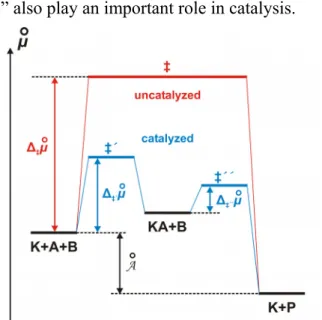CHEMICAL POTENTIAL IN KINETICS
R.Rüffler, G.JobJob-Foundation, Institute of Physical Chemistry, Grindelallee 117, 20146 Hamburg, Germany
e-mail: regina.rueffler@job-stiftung.de
Keywords: Chemical potential, kinetics
Everyday experience demonstrates that the rate of chemical reactions depends on temperature. For example, on a hot day food perishes much faster outside a refrigerator than inside. The exhaust gas catalytic converter in cars, an example for another possibility to influence the reaction rate, is also known to everybody. But what is the connection between these two phenomena? According to a well-established concept, the rate of a one-step reaction depends on the formation of an energy-rich transition complex, represented by ‡:
A BC A B C AB C
activation
+ ⋅⋅⋅ ⋅⋅⋅ → +
‡
.
The “ensemble” of all complexes can be considered as a kind of “substance” with a very short lifetime [1]. According to EYRING, this lifetime can be described for all complexes by h/kT (h Planck constant, k Boltzmann constant, T temperature). At room temperature, the lifetime of such complexes is around 100 femtoseconds. Despite its short lifetime, the concentration of this “transition substance” corresponds approximately to that expected in chemical equilibrium and can be calculated therefore by the mass action law. In the equation for the equilibrium constant, and thus for the reaction rate, the only individual quantity that appears apart from temperature, is the difference between the chemical potentials of the reactants and the products under standard conditions, symbolized by Δ‡μ○. The height of this
“potential barrier” (fig. 1) thus determines the reaction resistance, and therefore the reaction rate.
Figure 1. Potential diagram for characterization of the reaction rate. The standard values (black bars) and actual values (grey bars) of the reactants and products, as well as the transition complex ‡, are represented (Only in the case of the standard values can a potential barrier be observed which disappears in the case of the actual values because of the assumed equilibrium.).
“Potential barriers” also play an important role in catalysis.
Figure 2. Influence of a catalyst K on the potential barrier (The faster rate of formation and decomposition of the intemediate substance KA compared with the uncatalyzed reaction can be explained by lower potential barriers.).
Finally, important examples of applications like enzymatic and heterogeneous catalysis are discussed.
Selected illustrative demonstration experiments are suggested to arourse curiosity, to aid comprehension, and to forge links with everyday experiences.
[1] Job G., Rüffler R., Physical chemistry – an introduction with new concept and numerous experiments (in German), Wiesbaden: Verlag B.G. Teubner, 2007 (in preparation)

